Top 10 Beans and Legumes Highest in Protein
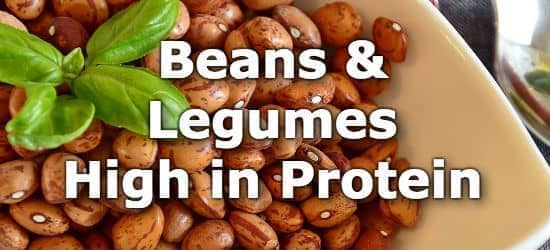
Beans and legumes are an inexpensive and heart-healthy group of foods, which are popular all around the world. In addition to being high in protein, beans and legumes are also good sources of fiber, iron, and potassium.
The current daily value (DV) for protein is 50 grams per day. (1) This is considered to be a healthy target amount for most people. Most beans provide between 29% and 36% of the DV for protein per cup cooked. Boiled soybeans (or edamame) provide a whopping 63% of the DV.
Beans and legumes that are particularly high in protein include soybeans, lentils, white beans, cranberry beans, split peas, pinto beans, kidney beans, black beans, navy beans, and limas. The list below is ranked by the most protein per cup cooked. This list includes only whole beans and legumes, not products made from these foods. For bean products like tofu and hummus see the extended list of beans and bean products high in protein.
List of High Protein Beans
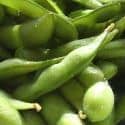 1 Boiled Soybeans (Edamame)
1 Boiled Soybeans (Edamame)| Protein per Cup | Protein per 100g | Protein per 200 Calories |
|---|---|---|
| 31.3g (63% DV) | 18.2g (36% DV) | 21.2g (42% DV) |
 2 Lentils
2 Lentils| Protein per Cup | Protein per 100g | Protein per 200 Calories |
|---|---|---|
| 17.9g (36% DV) | 9g (18% DV) | 15.6g (31% DV) |
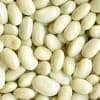 3 Large White Beans
3 Large White Beans| Protein per Cup | Protein per 100g | Protein per 200 Calories |
|---|---|---|
| 17.4g (35% DV) | 9.7g (19% DV) | 14g (28% DV) |
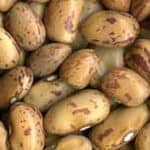 4 Cranberry (Borlotti) Beans
4 Cranberry (Borlotti) Beans| Protein per Cup | Protein per 100g | Protein per 200 Calories |
|---|---|---|
| 16.5g (33% DV) | 9.3g (19% DV) | 13.7g (27% DV) |
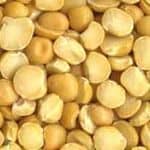 5 Split Peas
5 Split Peas| Protein per Cup | Protein per 100g | Protein per 200 Calories |
|---|---|---|
| 16.3g (33% DV) | 8.3g (17% DV) | 14.1g (28% DV) |
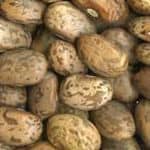 6 Pinto Beans
6 Pinto Beans| Protein per Cup | Protein per 100g | Protein per 200 Calories |
|---|---|---|
| 15.4g (31% DV) | 9g (18% DV) | 12.6g (25% DV) |
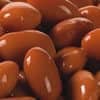 7 Kidney Beans
7 Kidney Beans| Protein per Cup | Protein per 100g | Protein per 200 Calories |
|---|---|---|
| 15.3g (31% DV) | 8.7g (17% DV) | 13.7g (27% DV) |
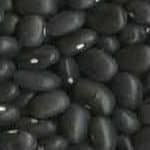 8 Black Beans (Frijoles Negros)
8 Black Beans (Frijoles Negros) | Protein per Cup | Protein per 100g | Protein per 200 Calories |
|---|---|---|
| 15.2g (30% DV) | 8.9g (18% DV) | 13.4g (27% DV) |
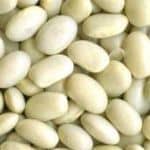 9 Navy (Haricot) Beans
9 Navy (Haricot) Beans| Protein per Cup | Protein per 100g | Protein per 200 Calories |
|---|---|---|
| 15g (30% DV) | 8.2g (16% DV) | 11.8g (24% DV) |
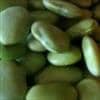 10 Lima (Butter) Beans
10 Lima (Butter) Beans| Protein per Cup | Protein per 100g | Protein per 200 Calories |
|---|---|---|
| 14.7g (29% DV) | 7.8g (16% DV) | 13.6g (27% DV) |
Printable One Page Sheet
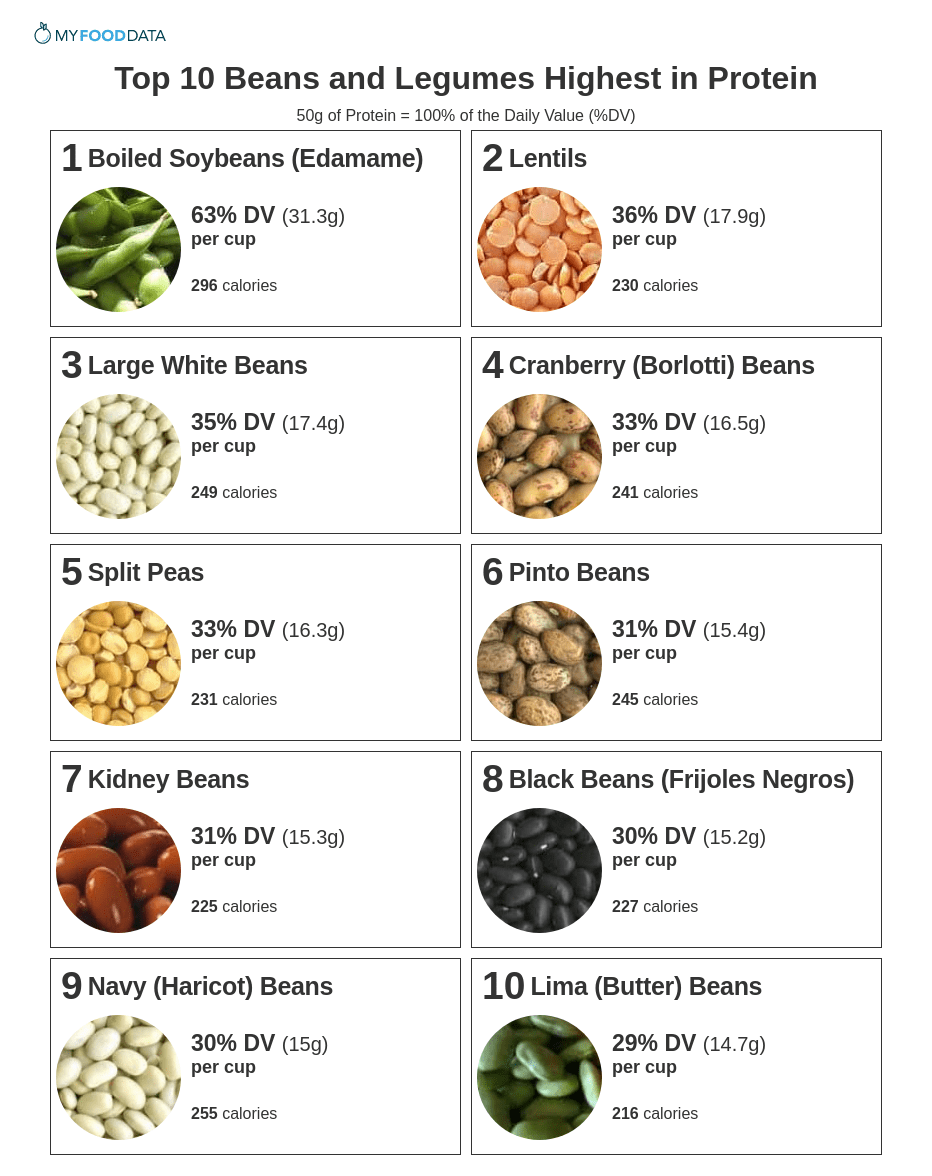
More Bean and Bean Products High in Protein
| Food | Serving | Protein |
|---|---|---|
| 1 Firm Tofu | per cup | 87% DV (43.5g) |
| 2 Tempeh | per cup | 67% DV (33.7g) |
| 3 Lupin Beans | 1 cup | 52% DV (25.8g) |
| 4 Adzuki Beans | per cup | 35% DV (17.3g) |
| 5 Great Northern Beans | per cup | 29% DV (14.7g) |
| 6 Chickpeas (Garbanzo Beans) | per cup | 29% DV (14.5g) |
| 7 Mung Beans | per cup | 28% DV (14.2g) |
| 8 Unsweetened Soymilk | per 16oz glass | 28% DV (14g) |
| 9 Mungo Beans | 1 cup | 27% DV (13.6g) |
| 10 Broad Beans (Fava) | per cup | 26% DV (12.9g) |
| 11 Peanut Butter | per 2 tblsp | 14% DV (7.1g) |
| 12 Peanuts (Dry Roasted) | per oz | 14% DV (6.9g) |
| 13 Falafel | 1 falafel | 5% DV (2.3g) |
| 14 Miso Paste | 1 tblsp | 4% DV (2.2g) |
| 15 Hummus | 1 tblsp | 2% DV (1.2g) |
About the Data
Data for the curated food lists comes from the USDA Food Data Central Repository.
You can check our data against the USDA by clicking the (Source) link at the bottom of each food listing.
Note: When checking data please be sure the serving sizes are the same. In the rare case you find any difference, please contact us and we will fix it right away.
About Nutrient Targets
Setting targets can provide a guide to healthy eating.
Some of the most popular targets include:- Daily Value (%DV) - The daily value (%DV) is a general guideline for consumption that will prevent deficiency of a particular nutrient in most people. The %DV refers to the percentage of an amount that's found in a single serving of a food. It also accounts for absorption factors. It is set by the U.S. FDA.
- Recommended Dietary Allowance (%RDA) - The RDA sets an average daily dietary intake level that is sufficient to meet the nutrient requirements of nearly all (97.5%) healthy individuals. It's more specific than the daily value, and varies by age and gender. The RDA is set by the US National Institutes of Health.
- Reference Dietary Intake (%RDI) -The reference dietary intake is similar to the recommended daily allowance, but is specific to age and gender. The RDI for amino acids is set by the U.N. World Health Organization.
- Adequate Intake (%AI) - This value is primarily used in reference to omega-3 and omega-6 fats. The Adequate Intake is set by the U.S. Institute of Medicine. Because there is less evidence to determine the ideal targets for consumption of these nutrients, the specific amount is considered to be less reliable. Using the term Adequate Intake, rather than one of the other terms, helps to emphasize that the ideal intake of that particular nutrient has not yet been scientifically determined.
See the Guide to Recommended Daily Intakes for more information.
Want to set your own targets? Sign up for an account and set custom targets in the daily meal planner.From the Nutrient Ranking Tool
Use the ranking tool links below to select foods and create your own food list to share or print.
- Foods High in Protein
- Foods Low in Protein
- Vegetables High in Protein
- Fruits High in Protein
- Vegetarian Foods High in Protein
- Nuts High in Protein
- Grains High in Protein
- Beans High in Protein
- Dairy High in Protein
- Breakfast Cereals High in Protein
- Fast Foods High in Protein
View more nutrients with the nutrient ranking tool, or see ratios with the nutrient ratio tool.
Related
Data Sources and References
Try the recipe nutrition calculator, or daily meal planner.
Create a free account to log and track foods.

